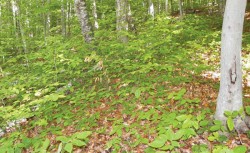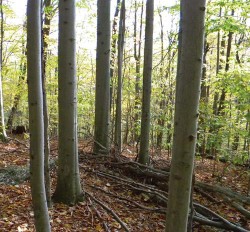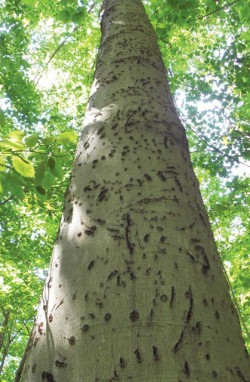Ask a group of foresters, tree farmers, or loggers how to promote American beech, and there will likely be a pause, a few grins, perhaps a chuckle or two, and then, the faint sound of crickets. That was pretty much the response when I posed the question last fall at a workshop sponsored by the New Hampshire Timberland Owners Association, the University of New Hampshire Cooperative Extension, and Proctor Academy in Andover, New Hampshire. While the workshop was billed as an ecumenical overview of managing beech – both for and against – the presentations, field visits, and related discussions were decidedly focused on eliminating (or at least minimizing) this pesky species. Nearly an hour-and-a-half was devoted to mechanical methods of beech removal and an in-depth discussion of several herbicides, including a demonstration of a backpack mounted power mist sprayer that can effectively rid the forest of any interlopers that might overshadow white pine seedlings. Finally, toward the end of the workshop, our host Dave Pilla, Woodland Manager for Proctor Academy, noted the wildlife values of beech, followed by UNH Extension Forester Tim Fleury’s reference to silvicultural treatments that can promote beech. Alas, that discussion was relatively brief.
This collective response reveals a long-established prejudice against beech, which arose primarily for two reasons: First, due to its tendency to check and warp and its susceptibility to beech bark disease, beech lumber commands a much lower price than its more favored hardwood brethren: sugar maple, white ash, and red oak. Secondly, beech is a fierce competitor wherever it occurs and has been the bane of many well-meaning foresters and landowners striving to manage for more commercially valuable species.
Nevertheless, this tenacious, native species is an important part of our New England forests and there are good reasons to appreciate and, yes, even promote, the presence of beech. As any wildlife biologist will tell you, beechnuts are something of a super food. Beech mast provides a considerable food source to a variety of animal species, most notably the black bear, but also white-tailed deer, marten, fisher, wild turkey, ruffed grouse, and many small mammals. Beechnuts have nearly the same protein content as corn and five times the fat. Compared to white oak acorns, beechnuts have nearly twice the crude protein and twice the fat. In addition to the wildlife benefits, sustaining beech in our northern forest maintains diversity, provides lower-valued hardwood for products such as tie logs and grade stakes, and, carefully kiln-dried, offers an affordable alternative to hard maple for cabinetry, flooring, and furniture.
And so, landowners and foresters find themselves in a sometimes paradoxical situation. On one hand, diseased beech is often the bully on the block – outcompeting valuable hardwood species and altering forest composition in negative ways. (This negativity is not just anthropomorphic: when a maple stand becomes a beech stand, the reverberations echo through the entire ecosystem.) At the same time, the beech mast in many stands is declining – to the detriment of the animals that depend on the nuts. Reflecting the prevailing sentiment at the NHTOA workshop, a quick Google search reveals a wealth of clinical information on controlling beech. But promoting it? Here, the literature gets thin.
Hex on the Beech
Before we explore the latest thinking on beech management, it’s important to know more about this species’ growth characteristics and its march through history, from keystone species to pariah.
There was a time when beech ruled the northern forest. “There’s been a monumental shift in the amount of beech from pre-settlement days, when there was a huge amount of beech everywhere,” said Charlie Cogbill, a plant ecologist with Hubbard Brook Experimental Forest. “In northern New England, it was 40 percent of the original forest throughout almost the entire area. Today, according to FIA data (Forest Inventory and Analysis, done by the USDA Forest Service), it’s more like 15 percent.”
According to Cogbill, beech was in decline throughout the region well before the notorious beech bark disease showed up in the late nineteenth century. The disease is actually a one-two punch: an insect attack pierces the tree’s thin bark and is followed by a fungal infection that eventually kills the tree. The offending insect is a soft-bodied scale that was accidentally introduced to Nova Scotia in 1890. The primary fungus is another European import, Neonectria faginata, but there’s also a native species (Neonectria ditissima) that’s causing damage in some areas.
Since the early twentieth century, the scale-Nectria complex has spread throughout the region, making it difficult to find a disease-free stand of beech today. Researchers estimate that between 1960 and 1980, Vermont lost 30 percent of its beech to the disease. Maine and New Hampshire, being closer to the outbreak in the Canadian Maritimes, were infected a decade or so earlier with similarly devastating results. In one nonmanaged stand in the Adirondacks, mast production declined by 37 percent between 1948 and 1992.
But unlike the American chestnut– a formerly abundant species that was nearly eliminated by an imported disease over 100 years ago – there’s still beech everywhere. The tree’s range stretches from Cape Breton Island, Nova Scotia, west to New England, southern Quebec and Ontario, down through the Midwest, all the way to northern Florida. Its favorite soil types are the gray-brown podzolic and granitic soils abundant throughout New England and upper New York State, though the research is replete with reports of beech’s ability to adapt to varying soil types, elevations, temperatures, and growing seasons. Create a small opening (less than half an acre) in a northern hardwood or oak/pine forest where beech is present in the overstory and, inevitably, beech will make itself known within the first growing season. How well known depends on a host of factors but, rest assured, beech will likely be competing for soil nutrients, moisture, and sunlight with more favored species.
“Beech is a phenomenal species whose reproductive ability allows it to persist in the face of a complex pathogen,” explained Dr. David Houston, a former USDA Forest Service ecologist and plant pathologist known for his decades of research on beech bark disease. “In many cases, we have more stems of beech per acre today than we did prior to the heavy high-grading of the past several decades.” Such harvesting practices focus on the more commercially valuable hardwoods and “trigger the root systems of the remaining beech, causing beech thickets to fill in the gaps,” he said. Houston’s impression is that while beech numbers are not in decline, the quality is, due in part to practices that promote disease-susceptible reproduction.
Managing as if Beech Mattered
In light of this, those looking to benefit wildlife by encouraging beech might be better off looking at the task as managing against the Nectria complex. In one 50-year study conducted at the US Forest Service’s Bartlett Experimental Forest, Bill Leak achieved notable success in significantly reducing “and nearly eliminating” beech bark disease in some stands by favoring trees that show signs of resistance or tolerance and culling those that don’t, a well-known silvicultural practice known as individual tree selection, or crop tree selection. [Editor’s note: See “How to Help your Best Trees Grow,” Spring 2012, to learn more.]
Selection is the operative word here, as it’s important not to over-cull a stand in an attempt to reestablish it. A key to judiciously applying the selection method to beech stands or individual beech trees in a mixed-wood stand is to recognize the difference between tolerant and resistant trees. Resistant trees are the big (over 10-inch DBH), beautiful specimens that show no signs of beech bark disease; such trees are immune to the scale attack, the vector necessary to introduce the Nectria fungi. Tolerants, on the other hand, are infected but still productive and can often live for many years with sublethal Nectria infections.
Although battle-weary tolerant trees may look unhealthy, it may not be necessary to remove them from the stand. One study showed that beechnut production dropped significantly only after an infected tree lost more than 25 percent of its crown. Another found a consistent, two-year masting cycle in a stand that had been infected for 40 years; in fact, in the eight year study period, beechnut production actually increased. A third study found no significant relationship between bear feeding activity (freshly clawed and unclawed trees) and the severity of Nectria fungus and beech scale, suggesting that bears do not have a strong preference for climbing healthier trees. These studies show that infected beech stands can be productive, and that wholesale removal of diseased trees may be unwarranted.
In 2011, Paul Hamelin, a certified wildlife biologist with the Vermont Agency of Natural Resources, brought together a host of natural resource professionals, including Houston, to craft a set of silvicultural guidelines for beech. The goal was to promote better timber quality (for all tree species), to improve beech mast production, and to genetically select for resistance to beech bark disease.
This report suggests establishing a 200-foot wide, uneven-aged buffer around the area in which you want to encourage beech. This maintains shade to prevent winter injury on the thin-skinned beech trees. Then, identify resistant trees, the tolerant trees that are good mast producers, and the ones you’re not quite sure of, and denote them as crop trees. As you’re identifying crop trees, look for the telltale claw marks of black bears, as heavy nut-producing trees become favorites of certain bears and exhibit multigenerational scars from repeated use. These same trees can become host to “nests” created by bears climbing high into the crown, breaking off limbs, pulling them inward, and lodging them in the crotch of branches.
Once your crop trees are established, release them on three sides, keeping guard trees on the south side to minimize sunscald. Do your work in winter to minimize injury to roots and boles. (Wounds may provide sites for scale colonization.) Revisit the stand every 10 to 15 years to update your crop tree designations. This summary is simplified, but the complete set of guidelines is available on the Vermont Fish and Wildlife Department’s website.
If you’re new to culling beech, beware: beech is well-known for root suckering – a highly successful vegetative reproduction method that has helped to give the species its bad reputation. Beech has an extensive root system with many roots in the top three to five inches of soil. Wounding or significant changes in light or temperature cause the roots to stimulate suckers (buds) that emerge as independent stems. Logging activity around the base of beech trees has been known to cause this. Research suggests that because of beech’s shade tolerance, root suckers that emerge in early spring are more likely to survive and persist in the understory. Winter logging minimizes the degree of sprouting the following spring. Whether diseased trees send out more suckers than healthy ones as a stress response remains a challenging question. According to Houston, “Trees vary in their propensity to sprout” and the particular cause of sprouting is not always easy to determine.
The root suckers of infected beech have the same genes as their parents and will allow the disease to persist, while simultaneously crowding out the establishment of possibly healthy beech trees from seeds. To combat this, some private forestry consultants have resorted to selective herbicide application or a controlled burn to eliminate the disease-susceptible suckers and restart the beech stand with beechnuts falling from the healthy overstory. Mechanical treatment can also be effective, depending on the size of the stand.
My forester colleagues and logger and tree farmer friends can be forgiven for taking my question about favoring beech less than seriously. We’ve all been trained to discriminate against the tree since the first time we picked up an axe, chainsaw, or herbicide sprayer. And yet, despite our war on this species and a disease that has ravaged its numbers, the American beech endures, proving that it intends to remain a part of our forests into the foreseeable future. To be sure, its reproductive capacity warrants control, but beech offers benefits worthy of deeper appreciation. Considering the decades of research and emerging literature, perhaps it’s time to bury the hatchet, or at least use it more sparingly, in our dealings with this misunderstood species.






Discussion *